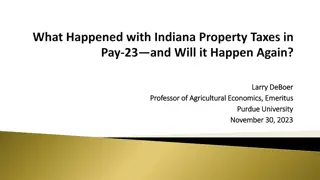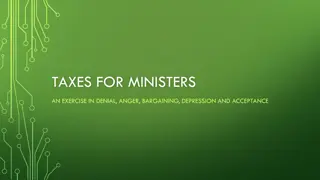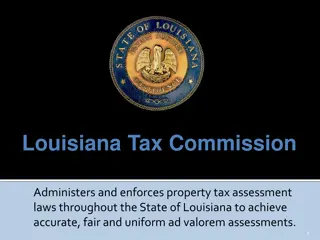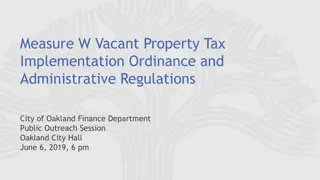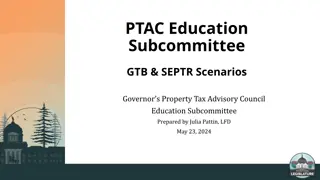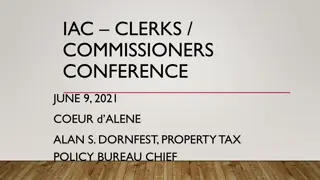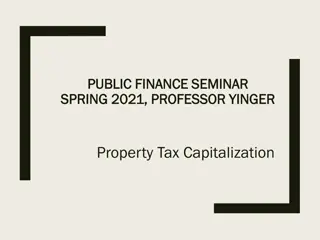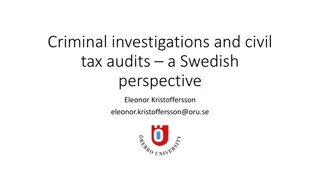Property Tax Trends in Indiana: A Comparative Analysis
Indiana's property tax landscape is examined through the lens of median homeowner property taxes, property tax revenue as a percentage of state income, and historical trends dating back to 1972. The state's ranking in terms of property tax burden, relative to other states, is highlighted, showcasing how Indiana compares in terms of property tax payments and revenue generation.
Download Presentation

Please find below an Image/Link to download the presentation.
The content on the website is provided AS IS for your information and personal use only. It may not be sold, licensed, or shared on other websites without obtaining consent from the author.If you encounter any issues during the download, it is possible that the publisher has removed the file from their server.
You are allowed to download the files provided on this website for personal or commercial use, subject to the condition that they are used lawfully. All files are the property of their respective owners.
The content on the website is provided AS IS for your information and personal use only. It may not be sold, licensed, or shared on other websites without obtaining consent from the author.
E N D
Presentation Transcript
Larry DeBoer Larry DeBoer Professor of Agricultural Economics, Emeritus Professor of Agricultural Economics, Emeritus Purdue University Purdue University November 30, 2023 November 30, 2023
How We Got Here: 1972 How We Got Here: 1972- - 2023 2023
The Bureau of Census American Community Survey estimates median homeowner property taxes for Indiana at $1,550, which is 8th lowest (44th highest) among the states and DC. Estimated Median Property Tax Payments by Homeowners with Mortgages by State, American Community Survey (U.S.Census), 2022 Alabama West Virginia Arkansas South Carolina Louisiana Mississippi IN (8th, $1,550) Tennessee Indiana KY (9th, $1,688 Kentucky Wyoming Delaware Oklahoma Arizona New Mexico North Carolina Nevada Missouri Idaho All of Indiana s neighbors have higher property tax median payments. Hawaii Utah Georgia Colorado Montana North Dakota South Dakota Florida Kansas Virginia OH (29th, $2,844) MI (32nd, $2,968) Ohio Indiana s median home value is $223,200, similar to our midwestern neighbors. The median state value is Wyoming s, at $315,700. Iowa Maine Michigan Minnesota Pennsylvania Nebraska WI (36th, $3,587) Wisconsin Oregon Maryland Alaska District of Columbia Washington Rhode Island Vermont Texas IL (45th, $5,350) Illinois California Massachusetts Connecticut New Hampshire New York New Jersey $0 $1,000 $2,000 $3,000 $4,000 $5,000 $6,000 $7,000 $8,000 $9,000 $10,000
Property Tax Revenue as Percent of State Income, 50 States and DC, 2021 As a percentage of state income, Indiana ranks 12th lowest (40th highest) among the states and DC. Alabama Arkansas Tennessee Oklahoma Louisiana New Mexico Delaware KY Kentucky North Carolina Nevada IN (12th) Idaho Indiana The ranking changes because Indiana s income is lower than the U.S. median, and Indiana s business property taxes a somewhat higher than its homeowner taxes, relative to other states. Utah West Virginia Arizona Missouri North Dakota Georgia South Dakota Washington Florida Mississippi Hawaii South Carolina Pennsylvania Maryland OH Ohio California Minnesota Virginia Colorado MI WI Michigan Oregon Wisconsin Kansas Wyoming Montana Iowa Massachusetts Nebraska Alaska IL Illinois Texas Rhode Island Connecticut New York New Hampshire District of Columbia New Jersey Maine Vermont 0% 1% 2% 3% 4% 5% 6% 7%
Property Tax Revenue as Percent of State Income, 50 States and DC, 1972 Indiana was not always a low property tax state. Alabama Alaska Delaware KY Kentucky Hawaii New Mexico Arkansas South Carolina 50 years ago, Indiana had the 41st lowest (11th highest) property taxes as a percentage of income in the U.S. West Virginia Mississippi Louisiana North Carolina Oklahoma Virginia Tennessee Georgia District of Columbia Florida Pennsylvania Maryland Idaho Nevada Utah Most states have reduced their property taxes relative to income, but Indiana has reduced them more than all but one other state (South Dakota). Missouri Texas North Dakota OH Washington Ohio Colorado Arizona IL Rhode Island Illinois MI Wyoming Michigan Kansas Minnesota Oregon Iowa IN (41st) Nebraska New York Indiana Maine Connecticut New Jersey South Dakota California Montana WI New Hampshire Wisconsin Vermont Massachusetts 0% 1% 2% 3% 4% 5% 6% 7%
Property taxes rose rapidly from 1951 to 1972. Otis Bowen s tax package passed in 1973. Indiana Property Taxes After Credits as Percent of Personal Income, 1951-2023 6% It reduced property taxes and slowed growth in three ways: 5% 4% Limits on the size and growth of the levy Replacing property taxes with sales taxes, moving tax collection from the local to state level Creating local income taxes for tax relief and added local revenue. 3% 2% 1% Indiana continued to apply these methods for 50 years. 0% 1951 1956 1961 1966 1971 1976 1981 1986 1991 1996 2001 2006 2011 2016 2021
Property Tax Controls Property Tax Controls Reduce Tax Growth Reduce Tax Growth Property Tax and Personal Income Growth over Four Periods, Average Annual Percentage Change, 1951-2023 Property taxes rose much faster than income from 1951-to 1972. 9.8% 10% Income Growth Property Tax Growth 9% 8.5% After property tax replacement credits reduced the tax level, maximum levy controls reduced tax growth. 8% 7% 6.5% 6.0% 5.6% 6% Exceptions to controls accumulated during 1981- 2007. 5% 4.2% 4% 3.4% 2.7% 3% After replacing school general funds with sales taxes, Circuit Breaker caps and a tighter maximum levy formula reduced property tax growth. 2% 1% School GF '07-08 PTRC '72-'74 0% 1951-1972 1974-1981 1981-2007 2008-2023
Indiana Total Sales Tax Revenue as Percent of Income, Fiscal Years Sales Taxes Rise to Reduce Sales Taxes Rise to Reduce Property Taxes Property Taxes 3.0% The increase from 2% to 4% in 1974 funded property tax replacement credits. 2.5% The increase from 5% to 6% in 2002 funded homestead credits to reduce the effect of reassessment on homeowners. 2.0% 1.5% The increase in from 6% to 7% 2008 allowed the elimination of the property tax for school general funds (now the education fund). 1.0% 4 percentage points of our 7% sales tax originated with property tax relief. 0.5% 0.0% 1957 1961 1965 1969 1973 1977 1981 1985 1989 1993 1997 2001 2005 2009 2013 2017 2021
Local Income Taxes rise to Local Income Taxes rise to reduce Property Tax Growth reduce Property Tax Growth Indiana Local Income Tax Certified Distributions, as Percent of Personal Income, 1974-2023 0.9% The first local income tax, CAGIT, was adopted by about 1/3 of Indiana counties in 1974. Most of these counties were rural. The revenue was used to mainly to reduce property taxes. 0.8% 0.7% 0.6% 0.5% COIT was introduced in 1984 and adopted by most of the bigger urban counties. Revenue could be added to budgets. 0.4% 0.3% 0.2% Through the 1990 s more income tax options were introduced, more counties adopted, and many increased their rates. 0.1% 0.0% 1974 1978 1982 1986 1990 1994 1998 2002 2006 2010 2014 2018 2022
Indiana State, Local and Combined Taxes as a Percentage of Income, 1961-2021 Shift to State Taxation Shift to State Taxation Indiana has shifted tax revenue collection from local government to the state, mainly by raising sales taxes to reduce property taxes. Local Taxes State Taxes Total State/Local Taxes 12% 10% In1972, 51% of Indiana taxes were collected at the local level. By 2021only 27% of total taxes were local. 8% The percent of income paid to local taxes has decreased; the percent paid to state taxes has increased. Total state and local taxes have remained near 10% for the past 30 years. 6% 4% 2% In 2021 Indiana s total state and local tax percent of income was 26th highest, which was the U.S. median value. Local Share, 1972: 51% Local Share, 2021: 27% 0% 1961 1965 1969 1973 1977 1981 1985 1989 1993 1997 2001 2005 2009 2013 2017 2021
Fifty years ago, Indiana property taxes were among the highest in the nation. Now they are among the lowest. Three policy approaches have achieved this reduction. oState controls reduce the growth of property tax revenue. The maximum levy was established in 1974, and the circuit breaker caps in 2010. oThe state sales tax rate was increase in 1974, 2002 and 2008 to fund property tax relief. The local share of total taxes fell from 51% in 1972 to 27% in 2021. oThe state authorized local income taxes, which all counties have now adopted. Some LIT revenue provides direct property tax relief. Spendable LIT reduces overall reliance on the property tax Despite the increases in sales taxes and LIT, overall state and local taxes remain near 10% of Indiana income, which is the median value for the United States.
What Happened in What Happened in Pay Pay- -23? 23?
Rising incomes, low interest rates and the slow recovery of home construction after the Great Recession began to increase home prices after 2013. Rising demand and restricted supply began to raise home prices by mid-decade. Home prices rose above 5% per year, 2018-2020. The pandemic increased demand for space. Prices accelerated after the pandemic. Peaking at 19% in 2022 Q2.
Farmland values peaked in 2014, fell until 2017, then remained near $7,000 per acre through 2020. Indiana Farmland Value per Acre, Average Land Class (Purdue Agricultural Economics, Annual Farmland Value Survey) 12,000 Values increased rapidly in 2021 and 2022, reaching a record high over $10,000 per acre. 10,000 8,000 Dollars per Acre Rising corn and soybean prices are a primary reason for the land value increase. 6,000 Selling prices are not used to determine farmland assessments. But the factors that change selling prices affect the base rate calculation in the same way. 4,000 2,000 0 1999 2001 2003 2005 2007 2009 2011 2013 2015 2017 2019 2021 2023
Materials, equipment and labor costs for constructing industrial buildings accelerated starting in July 2021, mainly due to shortages of building materials. The average annual inflation rate from 2010 through 2020 was 2.7%. Since then, it s been 16.6%.
o The effects of the pandemic and recovery on property values in 2020 and 2021 created the conditions for large assessed value increases in 2022-pay- 2023. o Home values had been rising more rapidly than usual due to lagging construction, rising incomes and low mortgage rates. The pandemic saw even lower mortgage rates and an increased demand for space. Values rose rapidly. o Farmland values rose to historic highs after the pandemic, mainly due to rising corn and soybean prices. o Business building construction costs rose due to shortages of building materials.
Indiana Total Gross Assessed Value Growth 14% 13.1% Assessed value growth accelerated after 2017 as home prices began rising faster. 12% 10% The pandemic increased the values of all real property in 2021, which led to the largest increase in gross assessed value in 20 years, for pay- 2023. 8% Percent Change 5.6% 6% 3.7%4.2%4.7% 4.2% 4% 3.1% 2.4%2.1%2.5% 1.6% 2% 1.0% 0.8% 0.2% 0% -0.5% -0.8% -2% 2008 2010 2012 2014 2016 2018 2020 2022 Pay-Year (GAV)
Real property assessments increased substantially in pay- 2023. Business personal property (business equipment) increased much more slowly.
Indiana Gross and Net Assessed Value Growth, 2022-23, by Property Type 25% In total, net assessed value grew faster than gross assessed value. 21.2% 20% 16.0% 16.0% 15.9% This is almost entirely due to the more rapid increase in homestead net assessed value, which occurred because of the fixed standard homestead deduction ($48,000) 15.2% 14.9% 14.6% 15% 13.1% 11.0% 10.3% 10% 5% 2.4% 2.2% 0% Homesteads Non-HS Residential Farmland Business Real Business Personal Total
The large increase in net assessed value was a statewide event, with 91 counties rising above 5%. 77 counties saw double-digit increases, and 32 had NAV increases above 15%. Benton County s decrease was entirely due to a large drop in personal property.
Property Taxes, Pay Property Taxes, Pay- -2023 2023 Net Assessed Values rose a lot. Net Levies were limited by the maximum levy growth quotient. Unit Tax Rates and District Tax Rates fell. Taxpayers with net AV increases greater than tax rate decrease saw tax bill increases. Where net AV increases were smaller, tax bills fell. Tax bill increases were not limited by circuit breaker caps, because caps are percentages of rising gross assessed value. Lower rates made fewer taxpayers eligible for tax cap credits.
Calculation of Property Tax Maximum Levy Growth Quotient 2002 - 2023 9% Growth Quotient: Six-year Average Growth, 2-year lag 2-year lag: 2023 Quotient based on 2016-2021 income growth The MLGQ is the average of Indiana non-farm income growth for six years, with a 2-year lag. 8% 7% 6% The MLGQ increased to 5% in 2023, because a high growth rate in 2021 replaced a lower growth rate in 2015 in the 6-year average. 5.0% 5% 4% 3% 2% 1% 0% 1995 1997 1999 2001 2003 2005 2007 2009 2011 2013 2015 2017 2019 2021 2023 -1% Added for 2023 Dropped for 2023 -2% Annual Growth Rates, Indiana Non-Farm Personal Income (Statewide) -3%
Total Levy Growth and Maximum Levy Growth Quotients 10% Since 2019 actual levies have grown faster than the maximum levy growth quotient. 8% Levy Growth In 2023, levies grew much faster, 8.8% compared to the 5% MLGQ. 6% 4% MLGQ 2% 0% -2% 2010 2012 2014 2016 2018 2020 2022
General funds and school operating funds are subject to the MLGQ. They grew only 5.3%. Debt funds and referendum funds are outside the MLGQ. Growth in those funds accounted for the rapid growth of the total levy.
Levy Growth by Unit Type, 2022-23 12% 10.7% 10.7% School corporations have most of the debt funds, and all the referendum funds. Rapid growth in school funds is the largest source of rapid levy growth. 10% 8.8% 8.1% 8% 7.5% 6.9% 5.8% 6% 4% 2% 0% County Township City/Town School Corp. Library Special Dist. Total
Net AV rose 14.6%, and levies increased 8.8%. The average decline in tax rates was about 5.8%. Pct. Pct. Change Change 2022 2022 2023 2023 Change Change County 0.5564 0.5200 -0.0363 -6.5% School and special district rate fell the least, library rates fell the most. Township 0.0931 0.0870 -0.0061 -6.6% City/Town 1.0290 0.9707 -0.0583 -5.7% School Corp. 1.1069 1.0585 -0.0484 -4.4% Library 0.1261 0.1167 -0.0093 -7.4% Special Dist. 0.1002 0.0995 -0.0007 -0.7%
Total Circuit Breaker Tax Cap Credits, 2010-2023 (Millions of Dollars) $1,200 2023 was the first time since 2015 that circuit breaker tax cap credits did not increase. $1,000 Tax rates fell and gross assessed values increased. Tax bills did not rise as much as gross AVs, so fewer taxpayers were eligible for tax cap credits, and those who were eligible received less. $800 $600 $400 $200 $0 2010 2011 2012 2013 2014 2015 2016 2017 2018 2019 2020 2021 2022 2023
Percent Change in Tax Cap Credits, 2010-2023 40% 162% 35% 2023 was the first time since 2015 that circuit breaker tax cap credits did not increase. 31.3% 30% 25% Tax rates fell and gross assessed values increased. Tax bills did not rise as much as gross AVs, so fewer taxpayers were eligible for tax cap credits, and those who were eligible received less. 20.8% 20% 15% 12.7% 10.5% 10% 6.2% 6.0% 5.3% 4.2% 5% 3.5% 3.1% 2.1% 0% -0.3% -0.9% -5% 2010 2011 2012 2013 2014 2015 2016 2017 2018 2019 2020 2021 2022 2023
Tax Cap Credits, Percent of Levy, 2010-2023 14% 12.3% Levies increased by 8.8% while tax cap credits decreased slightly. The share of levies lost to credits saw the biggest drop since circuit breakers were established. 12% 11.5% 11.5% 11.2% 10.7% 10.7% 10.8% 10.7% 10.7%10.4% 10.4% 10% 9.2% 9.0% 8% 7.0% 6% 4% 2% 0% 2010 2011 2012 2013 2014 2015 2016 2017 2018 2019 2020 2021 2022 2023
Levy Growth Before and After Tax Cap Credits, 2019-2023 12% Since circuit breaker tax cap credits did not increase, all the added levy was collected by local governments. Levy Before Credits 10.1% Levy After Credits 10% 8.8% 8% The increase in the post- credit levy was 10.1%, greater than the 8.8% increase in the levy itself. 6% 5.3% 5.3% 5.2% 4.5% 4.3% 4.2% 4.1% 4% 3.4% 2% 0% 2019 2020 2021 2022 2023
Estimated Change in Tax Bills by Property Type, 2022 Estimated Change in Tax Bills by Property Type, 2022- -23 23 25% 20.1% Big increases in net AV, smaller decreases in tax rates, and little change in tax cap credits produced substantial tax bill increases for all property owners except for personal property. 20% 17.4% 15% 13.1% 10.1% 10% 7.4% 5% 0% -2.0% -5% Homesteads Non-HS Residential Farmland Business Real Business Personal Total
o Real gross assessed values for pay 2023 increased substantially in response to the pandemic economy with large increases. Our assessment system does capture changes in property values. o Homestead net AVs rose even more, due to the fixed standard deduction. o Growth of levies under the maximum levy grew near the MLGQ rate of 5%. o Debt service and referendum levies grew much more, indicating that tax rates for these funds fell little, or were held constant. o Levies increased 8.8% in total, an unusually large increase. o Circuit breaker credits were almost unchanged, so post credit collections increased 10.1%. o Tax bills for all real property owners rose by unusually large amounts.
Will It Happen Again in Will It Happen Again in Pay Pay- -2024? 2024?
The home value increase peaked at 19% in mid- 2022 but was still 11% at the end of 2022. Selling prices in 2022 are incorporated into gross assessed values in 2023 and taxed in pay-2024.
Base Rate per Acre of Farmland for Property Taxation Pay 2007-24 and Forecasts to Pay 2032 Forecasts $3,000 The DLGF has already calculated the base rate for pay-2024, at $1,900. The base rate increase in 2023 was 16%. The rise from $1,500 to $1,900 in pay-2024 is 27%. $2,500 $2,050 $2,000 $1,900 $1,500 $1,500 $1,290 $1,000 $880 $500 $0 2007 2009 2011 2013 2015 2017 2019 Pay Year 2021 2023 2025 2027 2029 2031
Building construction inflation stopped after January 2023. But that means prices were still 33% higher in December 2022 than in December 2021.
Indiana Net Assessed Value Growth, Indiana Net Assessed Value Growth, 2023 and 2024, by Property Type 2023 and 2024, by Property Type (Non (Non- -HS Residential and Farmland estimated) HS Residential and Farmland estimated) Certified net assessed values by tax district for 2024 were posted on Gateway in November. 30% 26.7% Pay-2023 Pay-2024 Farmland net AVs are assumed to rise at the percentage increase in the base rate. Non-HS Residential is the remainder of the 2% category. 25% 21.2% 20% 16.0% 15.2% 14.6% 15% Total growth is lower, mainly due to slower growth in homestead and business real net assessments. 11.4% 11.0% 10% 5.9% 4.5% 5% 3.6% But 5.9% total growth is still a large increase compared to pre-2023 growth rates. 2.6% 2.2% 0% Homesteads Non-HS Residential Farmland Business Real Business Personal Total
16 counties have total net assessed value increases above 10%. This is more than usual, but many fewer than the 77 counties with double-digit increases in 2023. 5 counties saw decreases in net AV, compared to only one in 2023. Net AV in 33 counties grew between 0% and 5%, and in 38 counties, between 5% and 10%. Rural counties saw 6.6% increase in net AV, compared to 5.0% in urban counties. The large rise in farmland assessments may be the reason.
Maximum Levy Growth Quotient. Maximum Levy Growth Quotient. Limits the MLGQ for pay-2024 and 2025 to 80% of the usual calculation up to a 4% maximum. The MLGQ will be 4% in 2024, instead of near 5%. Assessed value growth will cause a bigger reduction in tax rates. Homestead Supplemental Deduction. Homestead Supplemental Deduction. Raises the deduction from 35% for most homeowners to 40% in pay-2024 and 37.5% in pay-2025. This will reduce homeowner tax bills by shifting tax burden to other property owners. Property at the circuit breaker caps will not be affected. School Operating Referendum Levy growth. School Operating Referendum Levy growth. Operating referendum growth is limited to 3% for pay-2024. Assessed value growth will require a reduction in referendum tax rates.
Suppose a homes gross AV rises 10% from $220,000 to $242,000. With the fixed standard deduction and a 35% supplemental deduction, net AV rises 12.8%. The increase in the supplemental deduction to 40% reduces this increase to 4.1%. The increase from 35 to 40 is 14.3%. The reduction in net AV growth is between 8 and 10 percentage points for most home values and gross AV growth rates. 40% Supplemental 40% Supplemental Deduction Deduction 35% Supplemental Deduction 35% Supplemental Deduction 2023 2023 2024 2024 Pct Pct Chg Chg 2024 2024 Pct Pct Chg Chg Gross Assessed Value Standard Deduction 220,000 242,000 10.0% 242,000 10.0% 48,000 48,000 48,000 Remainder Supplemental Deduction Net Assessed Net Assessed Value Value 172,000 194,000 194,000 60,200 67,900 77,600 28.9% 28.9% 126,100 126,100 12.8% 12.8% 116,400 116,400 4.1% 4.1% 111,800 111,800
Suppose levies in funds under the maximum levy rise 4%, debt rates remain constant, so levies rise at the net AV increase of 5.9%, and operating referendum levies rise 3%. Overall levies would increase about 4.5%. With net AV rising 5.9%, average tax rates would fall about 1.4%. Lower rates will make fewer taxpayers eligible for Circuit Breaker cap credits. With the small net AV increases, 2024 homestead tax bills would rise by about 2%, before tax cap credits. Compare to an estimated 17% tax bill rise this year. Business tax bill increases should be modest as well. Non-homestead residential tax bill increases could be near 10%, while farmland tax bill increases could exceed 20%.
o Property value increases continued in 2022, which affected assessments in 2023 and will affect tax bills in 2024. o Certified net assessed values have increased 5.9% in total. Homestead and business increases are less. Net AV in the 2% category shows a bigger increase, with farmland likely to increase the most. o Levies will rise less in 2024 than in 2023, because of tighter state limits on levy growth, and slower growth in net AV. o The increase in the supplemental deduction from 35% to 40% probably cut homestead net AV growth by 8 to 10 percentage points, to 3.6%. o Average homeowner tax bill increases in 2024 likely will be modest, much less than in 2023. o Farmland tax bills are likely to increase substantially.
Larry DeBoer Larry DeBoer Professor of Agricultural Economics, Emeritus Professor of Agricultural Economics, Emeritus Purdue University Purdue University November 30, 2023 November 30, 2023
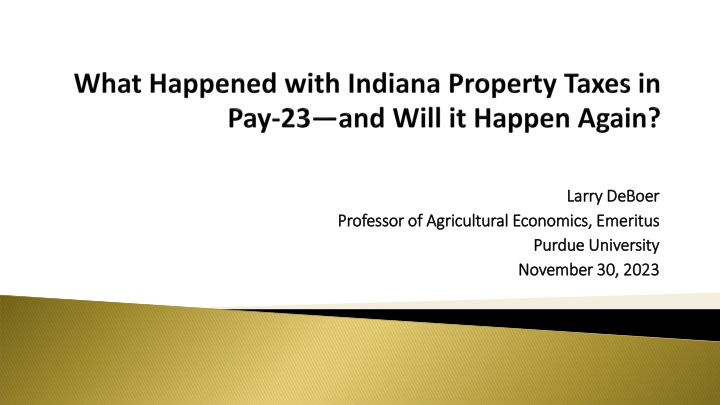


![Town of [Town Name] Real Estate Tax Rates and FY 2024 Budget Summary](/thumb/62211/town-of-town-name-real-estate-tax-rates-and-fy-2024-budget-summary.jpg)
